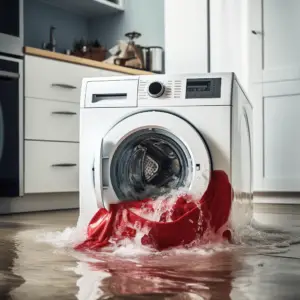Washing Machines, pan protects your property from water damages due to a leaking washer or the damaged water piping system. The rectangular-shaped pan, often constructed of plastic or metal, sits beneath the washer and fetches the washing machine overflow.
Table of Contents
Why Washing Drain Pan is Necessary
Drain pans aren’t mandatory for your washer, but they are a cheap and easy method to safeguard your house by collecting tiny leaks and minimizing water damage from damaged hoses. Washing Machines your laundry room is on the second floor, a drain pan is advised to prevent leaks from entering the rooms below.
One of the most common causes of flooding in the house is leaks and fractures in the hoses leading to your washing machine. A washing machine pan may help safeguard your house from flood damage by collecting water and emptying it securely.
The drain pan also protects the floor from dampness, which may contribute to the growth of mold and mildew under the washing machine.
How the Washing Drain Pan Works

A drainpipe must be attached to the washing machine drain pan for it to operate correctly. The pipe takes the water out and into a floor drain when the water level in the pan reaches a particular level.
Most drain pans include a pre-cut hole that allows connecting a PVC pipe to the pan directly. Either way, you’ll have to drill a new hole in the drain pan if your pan doesn’t have one.
The Washing Machine Drain Pan Alternatives
Valves that are Automatically Operated
It’s the most technologically advanced option on the list, but it is also the most adaptable and helpful. Automated Shut Off Valves are self-explanatory. The Washing Machine is connected to the water supply by a series of valves, and another set of valves then disposes of the used water.
Flooding occurs for the washing machine leak, and the valve cannot handle the increased water pressure or when there is a leak in the pipes. An automatic shutoff valve can help in such a situation.
The valve functions in two ways; the water level is detected via a sensor positioned on the floor. The sensor detects flooding if there is enough water to activate it.
When the sensor is activated, the water valve is instantly cut off. As a result, no water will leave the washing machine, and you will avoid detrimental damages.
The cost of an Automatic Shutoff Valve varies depending on the brand. There are additional differences made based on characteristics. However, a full kit can usually be found for $150. It is typically not a tough process to install. All you need are the appropriate tools and guidance from a professional.
Braided Hoses That Don’t Burst
Next, let’s look at a less high-tech but effective approach. In most homes, flooding is caused by leaking pipes or hoses. Hoses are the media through which water is transferred into and out of the washing machine.
Plastic or rubber hoses are commonly used due to their inexpensive cost and availability. They surely perform admirably. However, they are not the most long-lasting. At the very least, they’ll last as long as braided hoses.
What distinguishes braided rubber hoses from non-braided rubber hoses is that the whole lining of rubber hoses is made of a smooth rubber coating. The smooth lining has the disadvantage of quickly developing microcracks. As a result, even a hose that appears to be in good condition might leak and cause spillage.
Braided hoses flourish in a leaky environment. All of the braided and weaved hoses have structural stiffness that is significantly increased. The no-burst braided hoses can tolerate greater pressure. As a consequence, there is a lower risk of flooding and leakage.
Automatic Shut Off Laundry

The washing machine drain alternative is similar to the shutoff valve, except it turns off the complete system or the washing machine. A sensor has to be installed on the floor. It thinks there is a risk of flooding if it senses unwelcomed wetness on the floor and turns off the entire washing machine.
There are a few advantages to using this type of system. Many of these automated systems, for example, may be linked to smart gadgets applications. Smart home apps frequently allow users to link all of their home appliances from the palm of their hand.
Consequently,Washing Machines the customer wishes to alter any settings or even turn off the washing machine in the event of flooding, they can easily execute the order without getting off from their seats.
Conclusion
Washing machine users are frequently faced with the fear of flooding. Flooding has the potential to inflict significant harm. Therefore, the majority of the washing machine users choose to prevent floods through different strategies or restrict the source of water that causes flooding.
A drain pan includes a mechanism for draining water; spills and leaks can occur. If a large amount of water pours out and destroys furniture, resulting in slick flooring, it may be quite a problem.
Another significant issue is that if the flooding is too severe, it may result in significant damage to the floor or surrounding furnishings. This is especially problematic if the washer is located on the second story. Water may seep downstairs, and you’ll have to spend a lot of money to repair the damage.
A washing machine drain pan is used to avoid such dangers. Washing Machines a pan that fits beneath the washing machine. It just catches all of the extra water and prevents it from spilling. Drain Pans are often composed of sturdy plastic or metal.
Drain pans have the disadvantage of being low-tech. They won’t be able to stop the water from overflowing after a certain point. More contemporary techniques can successfully reduce floods.
Drain pans are a classic flood-prevention measure, but they can overflow, and there are better options. This article looked at various great alternatives for washing machine drain pans.
The information is expertly crafted to help you determine the best option for preventing flooding on your floor and furnishing due to the failure of washing machine drain pipes.


